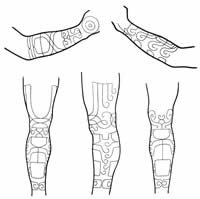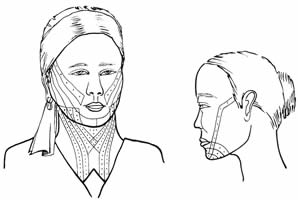 |
|||
| Celeb Tattoos | Facts & Stats | Designs & Symbols | History | Culture | Links | Tattoo Galleries | Contact | |||
|
|||
At The Tail of the Dragon: The Vanishing Tattoos of the Li People© 2006 by Lars Krutak The Li, comprised of five tribes, are the indigenous inhabitants of Hainan Island, China. It is believed that they migrated here more than 2,000 years ago from the mainland. The island of Hainan has approximately the same geographical area as Taiwan and lies at the same latitude as Hawaii. The word "Hainan" means "South of the Sea," but the Chinese likewise call their far southern possession "The Tail of the Dragon"; a wild place at the end of the Chinese world that at one time or another was considered more remote and mysterious than Tibet or Mongolia. The Li are one of fifty-five classified minority peoples of China, and by the 15th century Han Chinese immigrants began driving the Li into the southern mountains and forests forcing them to abandon their traditional settlements on the coastal plains of Hainan Island. With the establishment of the People's Republic of China in 1949, the communist government - adhering to an atheistic ideology - implemented policies of pochu mixin (eradicating superstitions) and yifengyisu (change prevailing customs and transform social traditions) that quickly collapsed the animistic religion of the Li: one that was based on ancestor worship and shamanism, as well as other salient cultural institutions including music, weaving, and tattooing. Yet it was the rapid decline of the Li economy, one based on the swidden agriculture of rice, that brought virtual extinction to the sociocultural milieu. Because land, the element in which the divine, mythic, and ritual components of life were deeply embedded, bound the Li together into a social fabric that was intricately woven within an integrated system of belief. This form of environmental enchainment engendered a form of life experience that was accreted collectively, since everything in the surrounding environment bore witness to Li existence, including physical and mental attributes, as well more metaphysical practices such as tattooing which were believed to carry individuals into the afterlife. LI RELIGIONAs noted, the Li were animists. They were guided in their spiritual affairs by shamans. Li shamans, through their communications with spirits, deities, and ancestors, functioned as mediators between the physical and supernatural realms. They could harness supernatural power to assure victory in war, hunting, and curing the sick. But the spiritual favors that were granted to successful mediators could only be achieved through the proper channels: that is if the spirits of the mountains and ancestors were properly "fed" by the shaman with sacrifices to gain their favor. If, however, the spirits were not properly propitiated, they often turned aggressive and malevolent towards humans and brought sickness or misfortune to the village. The Li concept of sickness was not, as in the West, attributable to bad health; it was a form of punishment, or a disruption of the social order, caused by not fulfilling social duties correctly. Sometimes sacrifices to the spirits were made in blood and were connected to the former Li practice of headhunting. Shamans not only captured the human blood for use in ritual, they also prepared the severed heads of slain enemies for burial near the entrance to the village, which was supposed to transform the spirits of the "war-dead" into guardians of the community. Although Li shamans were highly respected, their economic position in society was similar to the layperson because they regularly worked the rice fields just as others did. Here in the rice fields, the entire family unit worked together to transplant the rice plants and to harvest the crop. Oftentimes relatives from other villages provided additional labor and this collective agency not only established expansive socioeconomic networks linking households and villages for great distances across the Li landscape, but also provided a spiritual platform from which to petition the deities who controlled it. Women working the fields sang various songs in a harmonious fashion. And in these songs, the names of the spirits of the mountains and trees were invoked to beg their pardon from being disturbed as the soil was tilled. In the eyes of the Li, all musical expression, including performance with musical instruments, was a powerful medium that assisted humans in communicating with the spirits who protected the crops. And more importantly, skillful performance pleased the ancestors for it reproduced their agency and therefore memory in a cyclical perception of time.
LI TATTOOINGLi culture and cosmology, however, were not only embodied in musical traditions; they were also inscribed on the surfaces of the body as tattoo. All Li groups tattooed and the practice was more common among women, although men tattooed three blue rings around their wrists for medicinal purposes. Tattoo designs and motifs differed between each tribe, and sometimes they differed among families. One writer working for the National Geographic Magazine in the 1930s said you could "read the village, social standing, and identity" through a woman's tattoos; her woven textiles supposedly imparted similar information. When a Li girl of the Basadung tribe reached the age of thirteen or fourteen an old women, who was not necessarily a relative, first tattooed her on the nape of the neck and then on the face and throat in the course of four or five days. Over the next three years, her arms and legs were marked, unless somebody in the family died which interrupted the tattooing. The designs were stenciled on the skin with Chinese ink; then a thorn was used to prick the skin, followed by the rubbing of soot mixed with water into the wounds. The Meifu basically adhered to the Basadung practice while other groups created a chin tattoo that extended down the throat in two pairs of lines. These pairs of lines continued down the torso and across the breast moving downwards again to the belly meeting at the navel which they encircled. Li tattoos signified that a woman had become eligible to be married and traditionally the ritual was accompanied by an elaborate puberty ceremony in the village center. Li women interviewed in the 1930s said their tattoos not only made them beautiful, but allowed them to be recognized by their ancestors after death. VANISHING TATTOOSToday, contemporary Hainan is no longer the remote and mysterious wilderness situated at "The Tail of the Dragon." Traditional tattoos are now only worn on the bodies of a few elderly women in a handful of villages. Yet as these enduring fragments remain, they allow us to partially glimpse an indelible past shaped not by one hand but by many over successive generations of cultural practice that at one time connected ritual, myth, and nature from which Li tattoo culture ultimately sprang. LITERATUREClark, Leonard
Stübel, Hans
|
|||
|
Other tattoo articles by Lars Krutak
© 2006 Lars Krutak |
|||
| Celeb Tattoos | Facts & Stats | Designs & Symbols | History | Culture | Links | Tattoo Galleries | Contact |





